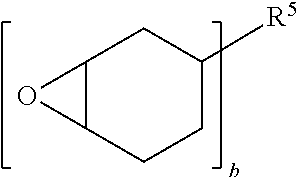Elastomeric epoxy materials and the use thereof
- Summary
- Abstract
- Description
- Claims
- Application Information
AI Technical Summary
Benefits of technology
Problems solved by technology
Method used
Image
Examples
example 1
Production of Epoxy Terminated Prepolymer
[0072]A 20 gallon stainless steel reactor is charged with 49.6 kg of DER™ 383 liquid epoxy resin, a reaction product of epichlorohydrin and bisphenol A, available from The Dow Chemical Company (epoxy equivalent weight=180.1 g / mol) with agitation followed by addition of 52.3 kg of Jeffamine™ T5000 polyoxyalkyleneamine, a polyoxypropylene triamine with a nominal molar mass of 5000 g / mol available from Huntsman Corp. (amine equivalent weight=952 g / mol). The vessel is degassed, padded with nitrogen and the temperature slowly increased to 125° C. via a heated jacket. The internal temperature is maintained at 120° C. and held for three hours. The vessel is then cooled to 80° C., the agitator stopped and the sample discharged. The epoxy terminated prepolymer is found to be a viscous liquid at 25° C. (approximately 90,000 cPs) with a measurable epoxy equivalent weight of 412 g / mol (463 actual).
examples 2 to 5
Elastomer Preparation
[0073]The epoxy terminated prepolymer prepared in Example 1, is added to lidded cups suitable for use in a FlackTek SpeedMixer™ and the sample mixed for 30 seconds at 800 rpm, then mixed at 2350 rpm for 1 minute to remove bubbles and then heated in a 54° C. oven. Then amine curing agent is added according to the formulations in the Table 1, the values are in parts by weight.
TABLE 123456C1*Epoxy Prepolymer from100100100100100100Example 1monoethanolamine6.65.01-amino-2-propanol8.11-amino-3-propanol8.12-amino-1-butanol9.6Triethylene tetramine1.05.2*Example C1 is a comparative.
[0074]After addition of the curing agent, the samples are mixed on a FlackTek SpeedMixer for 30 seconds at 800 rpm followed by 2350 rpm for 1 minute. The mixtures are then poured into closed aluminum molds that are preheated to 100° C. and treated with a mold release agent. The molds are placed back into the 100° C. oven and allowed to cure for approximately 1 hour, demolded and cooled to room...
examples 7 and 8
[0076]The epoxy terminated prepolymer prepared in Example 1, is added to lidded cups suitable for use in a FlackTek SpeedMixer and the sample mixed for 30 seconds at 800 rpm, then mixed at 2350 rpm for 1 minute to remove bubbles and then heated in a 54° C. oven. Then amine curing agent and DMP 30 (2,4,6-tris(dimethylaminomethyl) phenol) as catalyst were added according to the formulations in the Table 3.
TABLE 378Epoxy Prepolymer from Example 1100100monoethanolamine6.61-amino-2-propanol8.1DMP 303.23.2
[0077]After addition of the curing agent and catalyst, the samples are Speedmixed for 30 seconds at 800 rpm followed by 2350 rpm for 1 minute. The mixtures are then poured into closed, vertical molds that are preheated to 100° C. treated with a mold release agent. The molds are placed back into the 100° C. oven, allowed to cure for 12 minutes then demolded and cooled to room temperature for 24 hours. Tensile properties and DSC measurements are done as described above.
TABLE 4TensileStreng...
PUM
| Property | Measurement | Unit |
|---|---|---|
| Temperature | aaaaa | aaaaa |
| Temperature | aaaaa | aaaaa |
| Mass | aaaaa | aaaaa |
Abstract
Description
Claims
Application Information
 Login to View More
Login to View More - R&D
- Intellectual Property
- Life Sciences
- Materials
- Tech Scout
- Unparalleled Data Quality
- Higher Quality Content
- 60% Fewer Hallucinations
Browse by: Latest US Patents, China's latest patents, Technical Efficacy Thesaurus, Application Domain, Technology Topic, Popular Technical Reports.
© 2025 PatSnap. All rights reserved.Legal|Privacy policy|Modern Slavery Act Transparency Statement|Sitemap|About US| Contact US: help@patsnap.com



